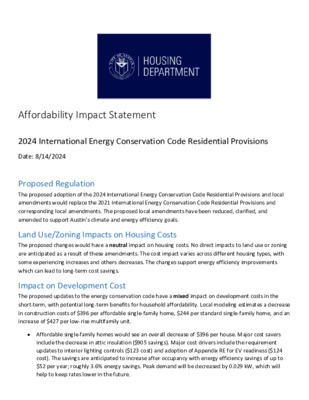Item 4: Energy Code 3 of 5 — original pdf
Backup

Affordability Impact Statement 2024 International Energy Conservation Code Residential Provisions Date: 8/14/2024 Proposed Regulation The proposed adoption of the 2024 International Energy Conservation Code Residential Provisions and local amendments would replace the 2021 International Energy Conservation Code Residential Provisions and corresponding local amendments. The proposed local amendments have been reduced, clarified, and amended to support Austin’s climate and energy efficiency goals. Land Use/Zoning Impacts on Housing Costs The proposed changes would have a neutral impact on housing costs. No direct impacts to land use or zoning are anticipated as a result of these amendments. The cost impact varies across different housing types, with some experiencing increases and others decreases. The changes support energy efficiency improvements which can lead to long-term cost savings. Impact on Development Cost The proposed updates to the energy conservation code have a mixed impact on development costs in the short-term, with potential long-term benefits for household affordability. Local modeling estimates a decrease in construction costs of $396 per affordable single-family home, $244 per standard single-family home, and an increase of $427 per low-rise multifamily unit. • Affordable single-family homes would see an overall decrease of $396 per house. Major cost savers include the decrease in attic insulation ($905 savings). Major cost drivers include the requirement updates to interior lighting controls ($123 cost) and adoption of Appendix RE for EV readiness ($124 cost). The savings are anticipated to increase after occupancy with energy efficiency savings of up to $52 per year; roughly 3.6% energy savings. Peak demand will be decreased by 0.029 kW, which will help to keep rates lower in the future. • Higher-cost single-family homes would experience an estimated decrease of $244 per house. Major cost savings include the reduction in attic insulation ($844 savings). Cost increases include interior lighting controls with sensors ($176 cost) and adoption of Appendix RE for EV readiness ($124 cost). The savings will further increase after occupancy with the increased energy efficiency and savings of up to $52 per year; roughly 4.5% energy savings. Peak demand will be decreased by 0.113 kW, which will help to keep rates lower in the future. • Low-rise multifamily developments (4 stories or less) would see an overall increase of $427 per unit. Major cost increases include adopting Appendix RE for EV readiness ($325 costs) and interior lighting controls ($105 costs), though due to Austin’s recent elimination of parking requirements, EV readiness would only be required if the development chose to build parking. The cost could be offset by the increased energy efficiency and savings of up to $77 per year per dwelling unit; roughly 6.7% energy savings per unit. Peak demand will be decreased by 0.116 kW per unit, which will help to keep rates lower in the future. Impact on Affordable Housing The proposed changes would have mixed impacts on affordable housing. Both positive and negative impacts are anticipated to affordable housing because of these amendments. For affordable single-family homes, there may be a construction cost decrease, and potentially further savings. For low-rise multifamily, there may be an initial construction cost increase, but that could potentially be reduced by providing less parking and offset by future energy savings long term. Other Policy Considerations The proposed amendments will decrease carbon emissions by 4.6%- 6.7% per home. This contributes to Austin's goal of net-zero community-wide greenhouse gas emissions by 2040 from the Austin Climate Equity Plan. Manager’s Signature _____ _________________________